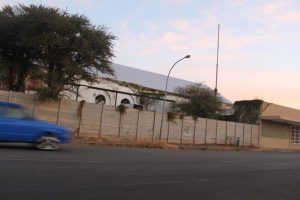UPDATED: 05/12/2023
5 DECEMBER 1924, Robert Sobukwe (pictured) born in Graaff Reinet.
5 DECEMBER 1941, Ganspan internment camp closed and all internees taken to Koffiefontein.
5 DECEMBER 1952, Constance Hall re-opens after renovations.
5 DECEMBER 1956, ZK Matthews arrested and charged with high treason.
Pictured is Robert Sobukwe walking in the Oppenheimer Gardens Kimberley.
ROBERT SOBUKWE BORN IN GRAAFF REINET
Robert Mangaliso Sobukwe was born in Graaff Reinet on Friday, 5 December 1924, the son of poor parents and the youngest of six children of Hubert Sobukwe and Angelina Gaziys.
Christmas for the Sobukwe family was celebrated with a new suit of clothes for each child. His father Hubert, originally from Lesotho, was a municipal worker, having been employed on the Graaff Reinet water scheme and as a part time woodcutter, and his mother Angelina, a Xhosa, was a domestic worker and a cook at the local hospital. Both encouraged all their children to pursue an education which they had never had.
Sobukwe was exposed to literature by his elder brother at an early age. He was educated at the Healdtown Institute, a Methodist mission school, and obtained a first class matriculation pass. He was Head Boy in his final year. He had, in fact, left school after Standard Six when he attended a Primary School Teacher’s Training course for two years but could not obtain a teaching post. He then returned to the Institute on a bursary where he completed his senior school education. During this period he suffered from tuberculosis, the disease putting a temporary halt to his education when he was hospitalized.
In 1947 he enrolled at Fort Hare University with the assistance of two small bursaries and financial assistance from the Principal of Healdtown in Fort Beaufort, and while reading for his BA degree, made his first impact on the political scene. He was elected SRC President and Secretary-General of the ANC Youth League. After graduation he obtained a diploma in teaching and became a teacher at Standerton but was dismissed after becoming a passive resister in the defiance campaign of 1952. Soon after he accepted a post at Wits University in the languages department.
Sobukwe identified with the Africanists within the ANC and in 1957 left the ANC to become Editor of The Africanist. A year later he and others broke away from the ANC and formed the PAC. The Pan African Congress held its first conference in 1959 where he was elected President.
He was released from prison in 1969 and was allowed to live in Kimberley with his family but remained under house arrest. Kimberley had been suggested as an area where he could not easily foster subversive activities and also a place where he could live and work, while being easily monitored by the state. At the same time he was also restricted through a banning order, which disallowed political activities.
Various restrictions barred him from travelling overseas, thus curtailing his attempts to further his education. For this same reason, he had to turn down several positions as a teacher at various locations in the United States.
Sobukwe completed his law degree with the help of a local lawyer, in Galeshewe, and then started his own practice in 1975 in Kimberley.
He died in Kimberley on 27 February 1978.
UPDATED: 05/12/2022
5 DECEMBER 1924, Robert Sobukwe born in Graaff Reinet.
5 DECEMBER 1941, Ganspan internment camp closed and all internees taken to Koffiefontein.
5 DECEMBER 1952, Constance Hall re-opens after renovations.
5 DECEMBER 1956, ZK Matthews arrested and charged with high treason.
(Pictured is the Constance Hall. Photograph of the entrance to the Hall by Andre Coetzee).
The Constance Hall
Originally, the Constance Hall was the Boiler room of the De Beers Mine in 1889. After the mine closed in 1908, the then General Manager of De Beers, Alpheus Fuller Williams, decided to turn it into a social hall, which was done, opening on 4 August 1911. It was named Constance in honour of Alpheus Williams’ wife Constance “Kips” Margaret Dalziel Smith, daughter of Dr J.A.J. Smith DSO, whom he had married in 1903.
Repair work was necessary in the 1950s and extensions were done in 1952 at a cost of £20 000. It was re-opened officially by Mr H.H. Taylor on 5 December 1952, and was utilized as a social hall until the mid-1990s when it became a discotheque known as Danskraal.
The building closed for some time but this year (2022) has seen a complete revamp and is known as The Blue Room.
At some stage in the 1960s the GW Rugby Union held their after match functions in the Constance Hall.
Next door to the Constance Hall is the original Cold Storage Room, at a later stage used by St John’s. The cold storage room was built before the siege of Kimberley in 1899, although the machinery only arrived after the siege had been lifted. Despite this, George Labram, the De Beers engineer, designed and manufactured a temporary plant that enabled the cold room to be utilized during the siege. The De Beers Company had decided on a cold storage room for three reasons: the recent loss of cattle to rinderpest (in 1897); the risk of insufficient supply to requirements; and to keep down the price of meat. The room measured some 31 152 cubic feet and could hold 6000 carcasses of sheep. The plant could also make 5 tonnes of ice daily.
Shortlink for this post: https://www.kimberley.org.za/?p=6765















